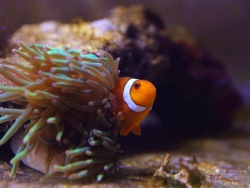Underwater arithmetic

The new aquaria system for invertebrates, which came into operation in the Primorsky Aquarium 2 months ago, is becoming inhabited. It helps to provide tropical mollusks, sea urchins, starfish and corals with conditions as similar as possible to the ones of their natural habitat. The equipment was purchased with assistance from the Konstantinovsky International Charitable Foundation.
Sea anemones and their inseparable companions – anemonefish, or clownfish – are settling into one of the fish tanks. “At first we placed three sea anemones to the tank. To feel well the animals should be kept together with clownfish, that is why we have added three Percula clownfish to the tank with the anemones,” said Vitaliy Sukhinin, Lead Specialist of the Exotic Animals Sector. “Clownfish and sea anemones have a symbiotic relationship; a fish chooses a suitable host animal itself. There are three anemones and three clownfish in the tank, and if people know that 3 is divisible by 3, the fish don’t think that it’s the right solution to this arithmetic problem. No matter how many anemones live in the tank, the clownfish will compete for one of them. Two sea anemones have sat close to each other, and, probably, the fish mistake them for one individual and go on fighting for it.”
To be chosen by a clownfish the anemone has to find an ideal place for living, which should be neither excessively nor poorly lit, without strong currents but permanently ventilated and inevitably safe. Having selected a sea anemone, the clownfish starts taking care of it; the fish cleans and feeds the animal, and aerates its tentacles. On catching some food, the clownfish tries to hide with it in a shelter usually provided by the sea anemone that always receives its share of prey. In return for this care the poisonous animal protects its clownfish from predators. The fish not only provisions and cleans the host anemone but also defends it: if the sea anemone is attacked, the small fish chases away the aggressor.